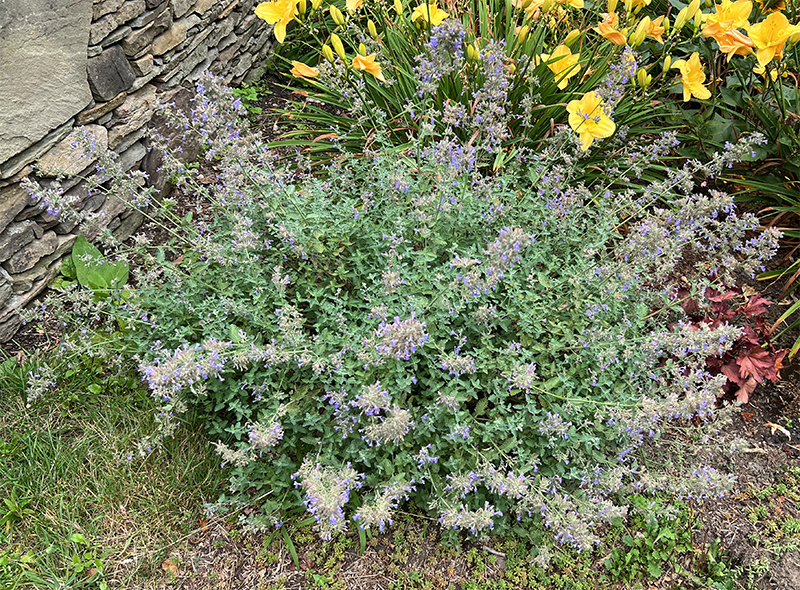If you’ve got mid-summer flowering perennials in your garden, chances are the flowerbed is looking pretty nice right now. The daylilies and Echinacea are in full bloom, and the cat mint (Nepeta) is still good enough. Yet at this point in the summer, I always get into the garden for a couple of hours to do some mid-summer maintenance. Some of what I do shows instant results, and other actions will result in more flower power as the summer goes on. Here are some tweaks and touchups you might find useful in your own perennial garden, but be sure that you do get into the flowerbed in the early morning, before the heat of the day.

The July garden is glorious, but that doesn’t mean that it can’t use some attention. Two hours of attention in the early morning will create a more beautiful garden for the rest of the summer and into the fall. Some of the Nepeta that’s on the left of the path in this photo will be cut back, and many of those spiky, yellow Verbascum will be removed.
Deadheading & Random Weeds
There is some deadheading to do in the July garden. Peonies, foxgloves, Verbascum, giant Allium and Heuchera all need to be deadheaded since their stalks topped with seeds aren’t attractive in the garden. In fact, my Verbascum chaixii is such a prolific self-seeder that most of the stalks get pulled from the garden completely at this time of year. Any stems that still are coming into flower are left for the bees. I cut off the dried peony flowers, and pull some of the foxglove seeds off of the stems to throw into the garden for next year. Even as I do this, I see young foxglove plants that have germinated from last year’s seeds. The deadheading doesn’t take long at this time of year, and as I move around the garden I pull the random weeds that are hiding underneath and beside the perennials.
Catmint
First, I decide what I want to do with my Nepeta, aka catmint. The beauty of this perennial is that no matter what you do, it’s fine for the rest of the summer. But trimming it back, or cutting it right to the ground, is not only possible but there are benefits to that approach. Here are the options, and what I’ve done in my garden.

This is how Nepeta looks as has gone past full bloom. The flowers are a lavender-gray, not blue, There are enough flowers to keep the bumblebees interested, but they aren’t working this plant as much now that most of the flowers are fading. You can leave your catmint as is, and it looks decent enough as long as long as the leaves don’t turn yellow from getting too dry.

Two of the Nepeta in my garden get this treatment in July. I cut off the biggest, oldest stems into the plant, and remove most of those outer stems that are growing horizontal, just above the ground. I got rid of a few yellowing stems, and trimmed a bit off the top. This plant will respond with some new, bushy growth and a few small flowers. The trimming keeps the plant full, and allows the other perennials and annuals around it to fill out and have the sun that they need.

I have two groups of 3 Nepeta plants that I cut right to the ground in July. Right after you do this the plants look kind of bare and sad, but within two weeks they will have produced new, fresh foliage from the ground. The advantage to this approach is that it opens up real estate for some annuals, and those will provide the serious flower-power in the garden into October. I tend to experiment with different annuals, but often I plant Profusion Zinnias. You can see three Apricot Profusion Zinnias on the left that I put into the garden in late June. But the plant with the dark soil around them are Profusion Red Yellow Bicolor plants that I grew from seed. Now that these are in the ground they will double their size very quickly, and be in flower until hard frost.

These are what I call “understudy annuals.” Just as an understudy actor is there to leap into the role should the primary player not be able to perform, so these annuals are ready to take the stage when they are needed. I grew these All America Selections winners from seed, and grew them on in 6″ pots. You can do something similar by buying the six-pack annuals of your choice (including many Profusion Zinnias) and repotting them into 6″ containers, along with a little time-release fertilizer. (Thanks to All America Selections for turning me onto this plant during the last GardenComm Virtual Conference! Note that if you want to be in the know about the newest plant varieties, you might want to attend the next GardenComm Virtual Conference this October.)
Before Stopping For The Day…
It took me just under two hours to deadhead, pull weeds, trim or cut the Nepeta, and plant the new Profusion Zinnias in the garden. But I couldn’t stop for the day before I sprayed those newly placed Zinnias with a bunny repellant. I have found that the key to keeping the rabbits from eating my flower garden is prompt spraying, both early in the season when Thumper’s favorites emerge (“Echinacea! Yum!”) and whenever any new plant get’s put into the garden. You want that rabbit to get the message from day one that these are not on the Bunny Buffet. You can use the homemade repellant from this blog, or Plantskydd, but the key is to spray the leaves of the plant with a liquid that is egg, milk or blood based. Granular repellants might be easier but they don’t work as well.

Right before I spray with a bunny repellant I pick up the piles of weeds and perennial foliage, and take them to the compost pile.

You might not see a big difference in this “after picture” but improvements have been made. The weeds I pulled won’t grow bigger, and the finished perennial stalks are gone. I’ll add some photos in a couple of weeks showing how the Nepeta has flushed out again, and how quickly the understudy plants have dominated the main stage.

Thanks for sharing!